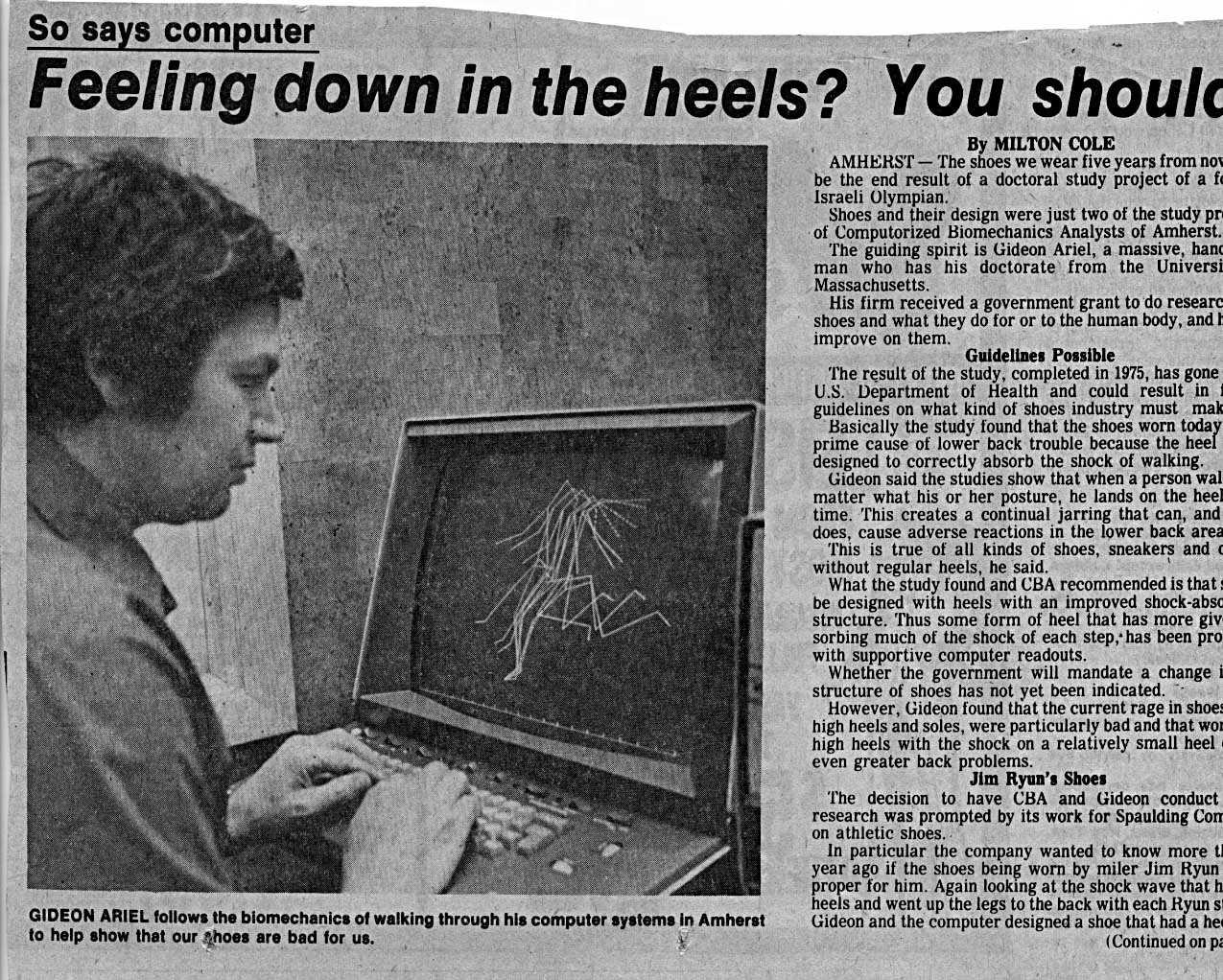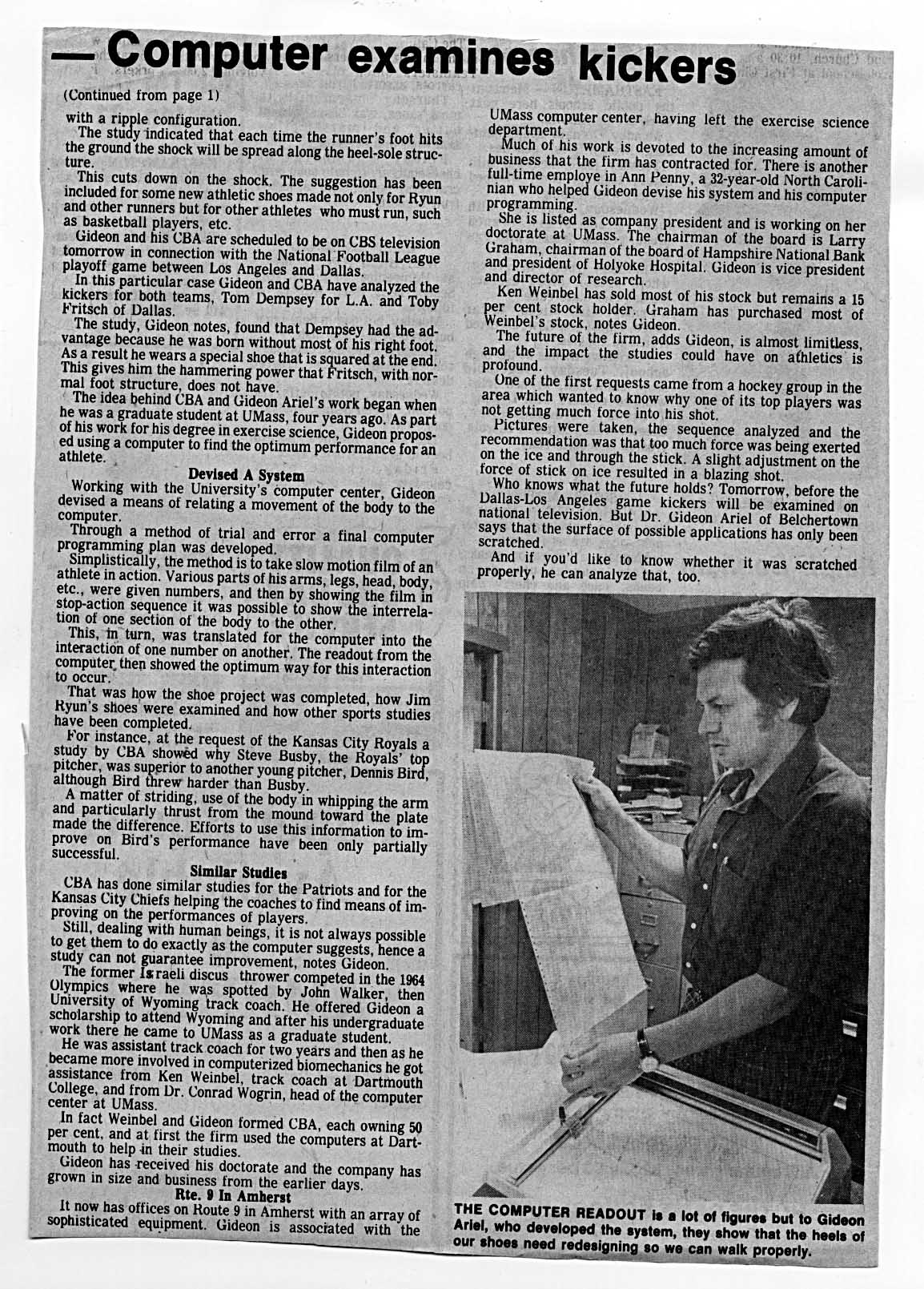So says computer
GIDEON ARIEL follows the blomechanics of walking through his computer systems In Amherst to help show that our shoes are bad for us.
By Milton Cole in Daily Hampshire Gazette on Thursday, April 1, 1976
Synopsis
The article discusses the work of Gideon Ariel, a computerized biomechanics analyst, who has conducted a study on the impact of shoes on the human body. The study, funded by a government grant, found that current shoe designs are a primary cause of lower back trouble due to their inability to properly absorb the shock of walking. Ariel's firm, Computorized Biomechanics Analysts, recommends a redesign of shoe heels to improve shock absorption. The study's findings have been submitted to the U.S. Department of Health and could potentially influence future shoe manufacturing guidelines. Ariel's firm has also conducted similar studies for sports teams, using computer analysis to optimize athletic performance.
Tip: use the left and right arrow keys
So says computer
Feeling down in the heels? You shoulc
GIDEON ARIEL follows the blomechanics of walking through his computer systems In Amherst to help show that our ?,hoes are bad for us.
By MILTON COLE
AMHERST - The shoes we wear five years from not be the end result of a doctoral study project of a fi Israeli Olympian.
Shoes and their design were just two of the study pr of Computorized Biomechanics Analysts of Amherst.
The guiding spirit is Gideon Ariel, a massive, hanc man who has his doctorate from the Universi Massachusetts.
His firm received a government grant to do researc shoes and what they do for or to the human body, and t improve on them.
Guidelines Possible
The result of the study, completed in 1975, has gone U.S. Department of Health and could result in I guidelines on what kind of shoes industry must mak
Basically the study found that the shoes worn today prime cause of lower back trouble because the heel designed to correctly absorb the shock of walking.
Gideon said the studies show that when a person wal matter what his or her posture, he lands on the heel time. This creates a continual jarring that can, and does, cause adverse reactions in the lower back area
This is true of all kinds of shoes, sneakers and c without regular heels, he said.
What the study found and CBA recommended is that be designed with heels with an improved shock-absc structure. Thus some form of heel that has more giv sorbing much of the shock of each step, has been pro with supportive computer readouts.
Whether the government will mandate a change i structure of shoes has not yet been indicated. -
However, Gideon found that the current rage in shoe! high heels and soles, were particularly bad and that woi high heels with the shock on a relatively small heel even greater back problems.
Jim Ryun's Shoes
The decision to have CBA and Gideon conduct research was prompted by its work for Spaulding Con on athletic shoes.
In particular the company wanted to know more ti year ago if the shoes being worn by miler Jim Ryun proper for him. Again looking at the shock wave that h heels and went up the legs to the back with each Ryun s, Gideon and the computer designed a shoe that had a hei
(Continued on p:
Computer examines
kickers
(Continued from page 1)
with a ripple configuration.
The study indicated that each time the runner's foot hits the ground the shock will be spread along the heel-sole structure.
This cuts down on the shock. The suggestion has been included for some new athletic shoes made not only for Ryun and other runners but for other athletes who must run, such as basketball players, etc.
Gideon and his CBA are scheduled to be on CBS television tomorrow in connection with the National Football League playoff game between Los Angeles and Dallas.
In this particular case Gideon and CBA have analyzed the kickers for both teams, Tom Dempsey for L.A. and Toby Fritsch of Dallas.
The study, Gideon notes, found that Dempsey had the advantage because he was born without most of his right foot. As a result he wears a special shoe that is squared at the end. This gives him the hammering power that Fritsch, with normal foot structure, does not have.
The idea behind CBA and Gideon Ariel's work began when he was a graduate student at UMass, four years ago. As part of his work for his degree in exercise science, Gideon proposed using a computer to find the optimum performance for an athlete.
Devised A System
Working with the University's computer center, Gideon devised a means of relating a movement of the body to the computer.
Through a method of trial and error a final computer programming plan was developed.
Simplistically, the method is to take slow motion film of an athlete in action. Various parts of his arms, legs, head, body, etc., were given numbers, and then by showing the film in stop-action sequence it was possible to show the interrelation of one section of the body to the other.
This, in turn, was translated for the computer into the interaction of one number on another. The readout from the computer, then showed the optimum way for this interaction to occur.
That was how the shoe project was completed, how Jim Ryun's shoes were examined and how other sports studies have been completed.
For instance, at the request of the Kansas City Royals a study by CBA showed why Steve Busby, the Royals' top pitcher, was superior to another young pitcher, Dennis Bird, although Bird threw harder than Busby.
A matter of striding, use of the body in whipping the arm and particularly thrust from the mound toward the plate made the difference. Efforts to use this information to improve on Bird's performance have been only partially successful.
Similar Studies
CBA has done similar studies for the Patriots and for the Kansas City Chiefs helping the coaches to find means of improving on the performances of players.
Still, dealing with human beings, it is not always possible to get them to do exactly as the computer suggests, hence a study can not guarantee improvement, notes Gideon.
The former Israeli discus thrower competed in the 1964 Olympics where he was spotted by John Walker, then University of Wyoming track coach. He offered Gideon a scholarship to attend Wyoming and after his undergraduate work there he came to UMass as a graduate student.
He was assistant track coach for two years and then as he became more involved in computerized biomechanics he got assistance from Ken Weinbel, track coach at Dartmouth College, and from Dr. Conrad Wogrin, head of the computer center at UMass.
In fact Weinbel and Gideon formed CBA, each owning 50 per cent, and at first the firm used the computers at Dartmouth to help in their studies.
Gideon has -received his doctorate and the company has grown in size and business from the earlier days.
Rte. i In Amherst
It now has offices on Route 9 in Amherst with an array of sophisticated equipment. Gideon is associated with the
UMass computer center, having left the exercise science dePartment.
Much of his work is devoted to the increasing amount of business that the firm has contracted for. There is another full-time employe in Ann Penny, a 32-year-old North Carolinian who helped Gideon devise his system and his computer programming.
She is listed as company president and is working on her doctorate at UMass. The chairman of the board is Larry Graham, chairman of the board of Hampshire National Bank and president of Holyoke Hospital. Gideon is vice president and director of research.
Ken Weinbel has sold most of his stock but remains a 15 per cent stock holder. Graham has purchased most of Weinbel's stock, notes Gideon.
The future of the firm, adds Gideon, is almost limitless, and the impact the studies could have on athletics is profound.
One of the first requests came from a hockey group in the area which wanted to know why one of its top players was not getting much force into his shot,
Pictures were taken, the sequence analyzed and the recommendation was that too much force was being exerted on the ice and through the stick. A slight adjustment on the force of stick on ice resulted in a blazing shot.
Who knows what the future holds? Tomorrow, before the Dallas-Los Angeles game kickers will be examined on national television. But Dr. Gideon Ariel of Belchertown says that the surface of possible applications has only been scratched.
And if you'd like to know whether it was scratched properly, he can analyze that, too.
O
THE COMPUTER READOUT is a lot of figures but to Gideon Ariel, who developed the system, they show that the heels of our shoes need redesigning so we can walk properly.


